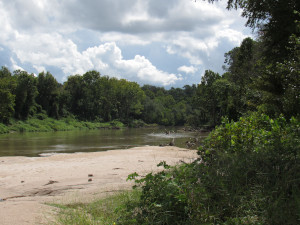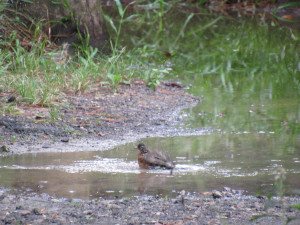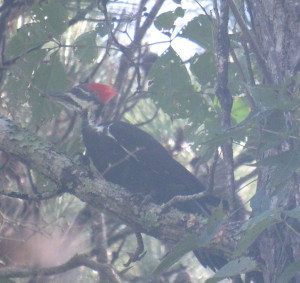A riparian woodland (riparian area, buffer, vegetation, zone, forest; streamside management zone; streamside zone; bottomland hardwood forest, etc.) is composed of the vegetated area on both sides of a stream that is under the influence of the stream from a surface/groundwater and geomorphology (geology/stream shaping) perspective. In many cases riparian woodlands are wetlands.
Riparian woodlands are more than a best management practice (BMP) used in forestry activities which acts as a filter strip to reduce sedimentation from logging or other disturbances. The benefits, uses, values, and functions of riparian woodlands include, but are not limited to:
1) Aesthetic (beauty and scenery)
2) Fish and wildlife habitat (food and shelter for endangered, game, non-game, and species of concern like Eastern Wild Turkey, Gray Squirrel, White-Tailed Deer, Pileated Woodpecker, etc.)
3) Aquatic and wetlands habitat enhancement and protection (pool/riffle creation, waterfalls, and downed tree food sources called coarse woody debris)
4) Sediment/nutrient pollution filtration
5) Water conservation/storage and cooling (provides vegetation shading of water)
6) Flood control/attenuation
7) Ecotone creation (allows edges of different habitats, like upland forests and aquatic areas, to come together and interact)
 8) Animal/plant migration routes (wildlife corridors)
8) Animal/plant migration routes (wildlife corridors)
9) Enhances vegetation/animal diversity, productivity, and density
10) Economic activities (logging, hunting fishing, birding, trapping, wildlife observation, and compatible recreational activities) (1, 2, 3)
Widths of riparian woodlands on ephemeral, intermittent, and perennial streams should be wider to accommodate, enhance, and maintain all benefits, uses, values, and functions that riparian woodlands provide. Research documents that wider riparian woodlands provide:
1) More habitat and use of that habitat by species like Gray Squirrels. (4)
2) Birds use perches, shrubby vegetation, and mature trees in riparian woodlands. (5)
3) Greater bird abundance. Interior forest birds like Yellow-billed Cuckoo, Acadian Flycatcher, Yellow-throated Vireo, and Pileated Woodpecker require wider riparian woodlands to survive. (6)
4) White-Tailed Deer show a significant preference for riparian woodlands during the fall/winter in East Texas. (7)
Before settlement in Texas there were approximately 16 million acres of bottomland hardwood forests and other riparian woodlands. In 1980, an estimate was made that 6,068,000 acres of bottomland hardwood forests and other riparian woodlands were left in Texas. This 1980 estimate included 3,062,000 acres of riparian woodlands that existed east of the Navasota River, 1,169,000 acres of bottomland hardwood forest in East Texas, and 1,742,000 acres of riparian woodlands in the rest of Texas. (8) Since 1980, the acreage of riparian woodlands has decreased.
References:
1) “Riparian and Floodplain Ecosystems: Functions, Values, and Management”, Mark M. Brinson, Eastern Energy and Land Use Team, National Water Resources Analysis Group, U.S. Fish & Wildlife Service, April 1980.
2) “An Overview of the Status of Riparian Ecosystems and the Application of Riparian Zone Management to Corps Projects”, Chester O. Marin, in “Proceedings of the U.S. Army Corps of Engineers Riparian Zone Restoration and Management Workshop, February 24-27, 1986”, Chester O. Marin and Hollis H. Allen, editors, Final Report, February 1988.
3) “Riparian Ecosystems: Their Ecology and Status”, Mark M. Brinson, Bryan L. Swift, Reuben C. Plantico, and John S. Barclay, Eastern Energy and Land Use Team, National Water Resources Analysis Group, U.S. Fish & Wildlife Service, August 1981.
4) “Riparian Zones and Wildlife in Southern Forests: The Problem and Squirrel Relationships”, James G. Dickson and Jimmy C. Huntley, pages 37-39, in “Managing Southern Forests for Wildlife and Fish – A Proceedings”, James G. Dickson and O. Eugene Maughan, editors, Department of Agriculture, U.S. Forest Service, Southern Forest Experiment Station, General Technical Report SO-65, 1987.
5) “Width of Forest Streamside Zones and Breeding Bird Abundance in East Texas”, Richard N. Conner, James G. Dickson, J. Howard Williamson, and Brent Ortego, Southeastern Naturalist, Volume 3, Number 5, pages 669-682.
6) “Streamside Zones and Breeding Birds in Eastern Texas”, James G. Dickson, J. Howard Williamson, Richard N. Conner, and Brent Ortego, The Wildlife Society Bulletin, Volume 23, Number 4, pages 750-755, 1995.
7) “Deer Use of Riparian Zones and Adjacent Pine Plantations in Texas”, Micah L. Poteet, Ronald E. Thill, R. Montague Whiting, Jr., and R. Lee Rayburn, “Proceedings Annual Conference of Southeastern Association of Fish & Wildlife Agencies,” 1996.
8) “Draft Texas Wetlands Conservation Plan”, Texas Parks & Wildlife Department, December 9, 1996.
Brandt Mannchen
September 6, 2018
Photographs by Duc Nguyen.